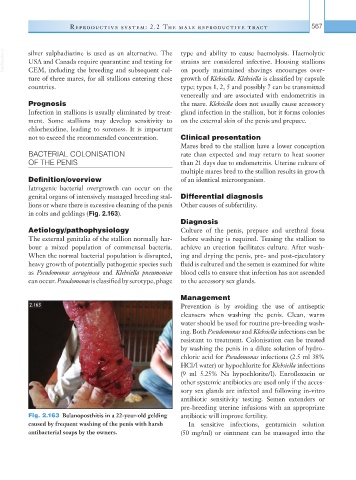Page 592 - Equine Clinical Medicine, Surgery and Reproduction, 2nd Edition
P. 592
Reproductive system: 2.2 The male reproductive tr act 567
VetBooks.ir silver sulphadiazine is used as an alternative. The type and ability to cause haemolysis. Haemolytic
strains are considered infective. Housing stallions
USA and Canada require quarantine and testing for
CEM, including the breeding and subsequent cul-
ture of three mares, for all stallions entering these on poorly maintained shavings encourages over-
growth of Klebsiella. Klebsiella is classified by capsule
countries. type; types 1, 2, 5 and possibly 7 can be transmitted
venereally and are associated with endometritis in
Prognosis the mare. Klebsiella does not usually cause accessory
Infection in stallions is usually eliminated by treat- gland infection in the stallion, but it forms colonies
ment. Some stallions may develop sensitivity to on the external skin of the penis and prepuce.
chlorhexidine, leading to soreness. It is important
not to exceed the recommended concentration. Clinical presentation
Mares bred to the stallion have a lower conception
BACTERIAL COLONISATION rate than expected and may return to heat sooner
OF THE PENIS than 21 days due to endometritis. Uterine culture of
multiple mares bred to the stallion results in growth
Definition/overview of an identical microorganism.
Iatrogenic bacterial overgrowth can occur on the
genital organs of intensively managed breeding stal- Differential diagnosis
lions or where there is excessive cleaning of the penis Other causes of subfertility.
in colts and geldings (Fig. 2.163).
Diagnosis
Aetiology/pathophysiology Culture of the penis, prepuce and urethral fossa
The external genitalia of the stallion normally har- before washing is required. Teasing the stallion to
bour a mixed population of commensal bacteria. achieve an erection facilitates culture. After wash-
When the normal bacterial population is disrupted, ing and drying the penis, pre- and post-ejaculatory
heavy growth of potentially pathogenic species such fluid is cultured and the semen is examined for white
as Pseudomonas aeruginosa and Klebsiella pneumoniae blood cells to ensure that infection has not ascended
can occur. Pseudomonas is classified by serotype, phage to the accessory sex glands.
Management
2.163 Prevention is by avoiding the use of antiseptic
cleansers when washing the penis. Clean, warm
water should be used for routine pre-breeding wash-
ing. Both Pseudomonas and Klebsiella infections can be
resistant to treatment. Colonisation can be treated
by washing the penis in a dilute solution of hydro-
chloric acid for Pseudomonas infections (2.5 ml 38%
HCl/l water) or hypochlorite for Klebsiella infections
(9 ml 5.25% Na hypochlorite/l). Enrofloxacin or
other systemic antibiotics are used only if the acces-
sory sex glands are infected and following in-vitro
antibiotic sensitivity testing. Semen extenders or
pre-breeding uterine infusions with an appropriate
Fig. 2.163 Balanoposthitis in a 22-year-old gelding antibiotic will improve fertility.
caused by frequent washing of the penis with harsh In sensitive infections, gentamicin solution
antibacterial soaps by the owners. (50 mg/ml) or ointment can be massaged into the

